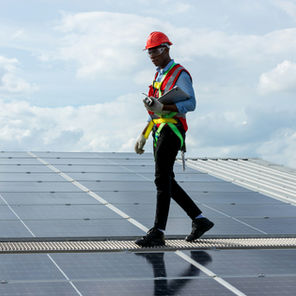
Expert Energy Project Financing Consulting Services
Structured capital stacks, due diligence and financing strategies for $5M–$200M renewable, storage, power and waste-to-energy projects.
As a leading Canadian international commercial project consulting firm, Amimar International advises on energy projects ranging from $5 million to $200 million. We specialize in renewable generation, grid-scale and distributed storage, power plants and advanced waste-to-energy assets. Our role is to design bankable capital structures, build lender- and investor-ready documentation, and guide sponsors through the complex world of debt, tax equity, incentives and private capital so viable projects actually reach financial close.
But first...
What is Energy Project Financing?
Energy project financing is the arrangement of long-term capital (construction and term loans, project bonds, tax equity, mezzanine capital and sponsor equity) to develop, expand or refinance energy assets such as solar, wind, storage, hydropower and waste-to-energy facilities. Most structures are non-recourse or limited-recourse, with lenders and investors looking primarily to contracted or merchant cash flows, offtake agreements and project-level security rather than the sponsor’s balance sheet.
Energy Project Financing Services
Comprehensive consulting services designed to maximize your energy project's financial success and minimize investment risks.
-
Technical Due Diligence: Comprehensive technical assessments covering technology validation, performance analysis, construction risk evaluation, and long-term operational feasibility. Our technical due diligence ensures investors have complete confidence in project viability.
-
Commercial Due Diligence: In-depth market analysis, revenue projections, competitive positioning, and commercial risk assessment. We evaluate market dynamics, pricing strategies, and long-term commercial sustainability to optimize project returns.
-
Risk Assessment & Management: Identification, quantification, and mitigation strategies for technical, commercial, regulatory, and financial risks. Our comprehensive risk framework protects investor interests and enhances project bankability.
-
Financial Modelling & Feasibility: Advanced financial modelling incorporating cash flow analysis, sensitivity testing, scenario planning, and return optimization. Our models provide the foundation for successful project financing negotiations.
-
Strategic Advisory Services: Strategic guidance on project structure, financing options, market positioning, and partnership development. We help clients navigate complex decisions to achieve optimal project outcomes.
-
Project Development Support: End-to-end project development assistance including feasibility studies, permit coordination, contractor selection, and construction oversight. We ensure projects progress smoothly from concept to completion.
Required Agreements for Project Qualification
Successful energy project financing requires a comprehensive suite of agreements and permits that demonstrate project viability and mitigate investor risks.
Power Purchase Agreements (PPAs)
Long-term contracts with creditworthy off-takers ensuring revenue certainty. Well-structured PPAs, including pricing and terms, maximize project attractiveness to lenders and investors.
Equipment Procurement Contracts
Fixed-price, turnkey construction contracts with established technology providers. We evaluate contractor capabilities, technology warranties, and performance guarantees to minimize construction and technology risks.
Grid Connection Agreements
Interconnection studies, grid impact assessments, and connection agreements with local utilities. We verify grid requirements to ensure reliable project interconnection and power delivery.
Feedstock Agreements
For bioenergy and waste-to-energy projects, securing reliable feedstock supply agreements is critical. Structuring long-term supply contracts with pricing mechanisms protect project economics.
Land Use & Environmental Permits
Comprehensive permitting strategy covering environmental assessments, land use approvals, and regulatory compliance. We coordinate with project sponsors to ensure all necessary permits are secured and maintained.
Due Diligence Documentation
Comprehensive documentation packages including technical studies, financial models, legal opinions, and insurance coverage. We ensure all investor requirements are met for successful financing closure.

Energy Project Financing Structure
A typical 2025 capital stack for utility-scale renewable energy projects includes:
-
Senior Construction and Term Debt: Often 50%-70% of total project cost, depending on technology, offtake profile and market risk.
-
Tax Equity or Similar Incentive Structures: In some jurisdictions, tax equity and incentives can provide 20%-40% of the capital stack, monetizing tax credits and accelerated depreciation where available.
-
Sponsor & JV Equity: Typically 10%-30% of project cost, including development spend, interconnection deposits and cash equity.
For storage, hybrid and waste-to-energy projects, structures are more bespoke, but the same logic applies: senior debt is the cheapest capital, tax and incentive structures are powerful but complex, and sponsor equity aligns interests and supports bankability.

2025 Energy Market Insights
Latest market intelligence and investment trends shaping the global energy financing landscape.
Global energy investment is set to exceed USD 3 trillion in 2024, with roughly USD 2 trillion flowing into clean energy technologies and infrastructure, including renewables, grids and storage.
Within that, renewable energy investment alone reached around US$807 billion in 2024, and is projected to keep growing as the global renewable energy market expands from about US$1.5 trillion in 2024 to nearly US$4.9 trillion by 2033.
At the same time, record additions of solar and wind capacity show that the transition is accelerating, even as capacity growth still falls short of 2030 targets.
For developers, this means capital is available, but heavily focused on projects that demonstrate robust contracts, realistic production and credible risk mitigation.
$386B
Record Global Investment
Global renewable energy investment reached a record $386 billion in the first half of 2025, representing a 10% increase from the previous year, demonstrating continued strong investor confidence in the energy transition.
Industries We Serve
-
Renewable Energy - Solar, wind, hydro, and geothermal projects with comprehensive financing solutions and technical expertise.
-
Power Generation - Conventional and renewable power plants with focus on grid-scale electricity generation projects.
-
Energy Storage - Battery storage, pumped hydro, and emerging storage technologies for grid stabilization and renewable integration.
-
Waste-to-Energy - Advanced waste processing facilities converting municipal and industrial waste into clean energy and valuable byproducts.
-
Industrial Energy - Energy efficiency upgrades, cogeneration systems, and industrial renewable energy installations.
-
Commercial Real Estate - Energy infrastructure for real estate, tourism, and hospitality projects requiring sustainable energy solutions.
Start Your Energy Project Financing Journey
Ready to transform your energy project vision into reality? Contact our expert team for a comprehensive consultation.






